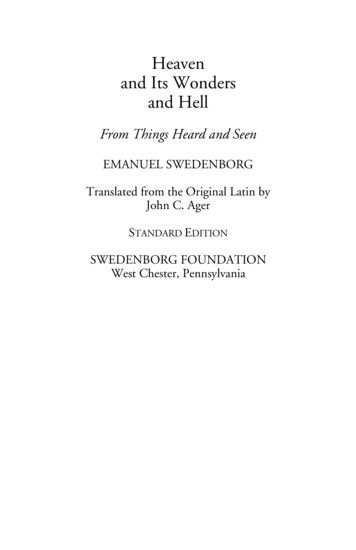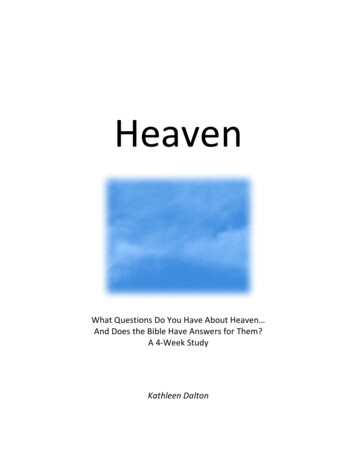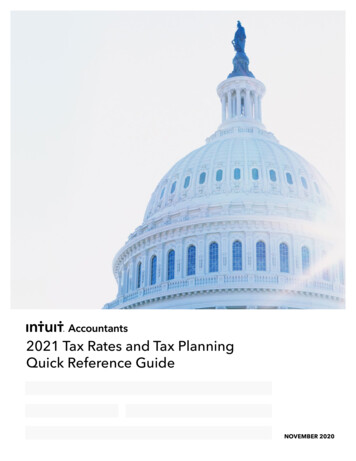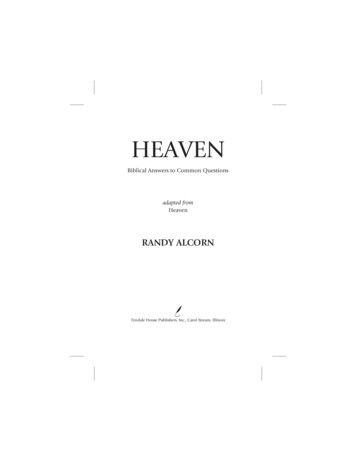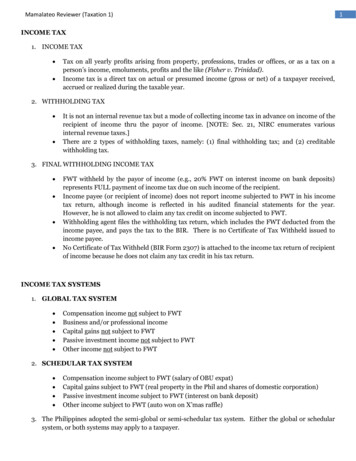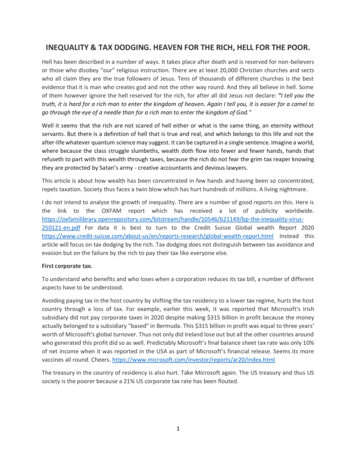
Transcription
INEQUALITY & TAX DODGING. HEAVEN FOR THE RICH, HELL FOR THE POOR.Hell has been described in a number of ways. It takes place after death and is reserved for non-believersor those who disobey “our” religious instruction. There are at least 20,000 Christian churches and sectswho all claim they are the true followers of Jesus. Tens of thousands of different churches is the bestevidence that it is man who creates god and not the other way round. And they all believe in hell. Someof them however ignore the hell reserved for the rich, for after all did Jesus not declare: "I tell you thetruth, it is hard for a rich man to enter the kingdom of heaven. Again I tell you, it is easier for a camel togo through the eye of a needle than for a rich man to enter the kingdom of God."Well it seems that the rich are not scared of hell either or what is the same thing, an eternity withoutservants. But there is a definition of hell that is true and real, and which belongs to this life and not theafter-life whatever quantum science may suggest. It can be captured in a single sentence. Imagine a world,where because the class struggle slumbeths, wealth doth flow into fewer and fewer hands, hands thatrefuseth to part with this wealth through taxes, because the rich do not fear the grim tax reaper knowingthey are protected by Satan’s army - creative accountants and devious lawyers.This article is about how wealth has been concentrated in few hands and having been so concentrated,repels taxation. Society thus faces a twin blow which has hurt hundreds of millions. A living nightmare.I do not intend to analyse the growth of inequality. There are a number of good reports on this. Here isthe link to the OXFAM report which has received a lot of publicity irus250121-en.pdf For data it is best to turn to the Credit Suisse Global wealth Report rts-research/global-wealth-report.html Instead thisarticle will focus on tax dodging by the rich. Tax dodging does not distinguish between tax avoidance andevasion but on the failure by the rich to pay their tax like everyone else.First corporate tax.To understand who benefits and who loses when a corporation reduces its tax bill, a number of differentaspects have to be understood.Avoiding paying tax in the host country by shifting the tax residency to a lower tax regime, hurts the hostcountry through a loss of tax. For example, earlier this week, it was reported that Microsoft's Irishsubsidiary did not pay corporate taxes in 2020 despite making 315 billion in profit because the moneyactually belonged to a subsidiary "based" in Bermuda. This 315 billion in profit was equal to three years’worth of Microsoft’s global turnover. Thus not only did Ireland lose out but all the other countries aroundwho generated this profit did so as well. Predictably Microsoft’s final balance sheet tax rate was only 10%of net income when it was reported in the USA as part of Microsoft’s financial release. Seems its morevaccines all round. Cheers. dex.htmlThe treasury in the country of residency is also hurt. Take Microsoft again. The US treasury and thus USsociety is the poorer because a 21% US corporate tax rate has been flouted.1
The gainers.The gainers are of course the shareholders in the headquartered country. Tax dodging does not increasethe mass of profits. No, that is not true, it can raise the mass of profits if local taxes such as sales orproperty taxes are avoided in any country. This applies in particular to digital corporations like Google andFacebook and ecommerce corporations like Amazon and eBay. Setting this aside, what is important toshareholders is not profits perse, but post tax profits as these fund share buy-backs and dividends. Thusin aggregate the headquartered country does not lose income, its’ just that this income goes into thehands of the top 1% who own most of the shares and not into the hands of the rest of society via the UStreasury.Over the years corporate tax rates have fallen precipitously. As the first graph shows this applies to boththe actual and effective tax rate, the latter having been reduced by tax breaks and tax swerves in othercountries. Fortune puts the effective tax rate at below 10%, Yardeni puts it at 14% and the BEA at 16%.Graph 1.Graph 2.2
Graph 3.TAX RATES: TOTAL & NON-FINANCIAL ncial tax 5010.0%total corporate tax rateI consider Graph 3 based on NIPA Table 1.14 the most accurate because it strips out fictitious profits andbecause it is based on IRS data. As a result of the reduction in the effective corporate tax rate, corporatetax as a share of GDP has fallen fourfold.Graph 4.CORPORATE TAX PAID as a SHARE OF 47-01-011.00%It is not only in the USA that corporate tax rates have fallen, its’ a worldwide phenomenon. That averagehas been driven down primarily by the relatively higher falls in the dominant economies such as the USAwhich we have been investigating. On average dominated or emerging economies have higher rates ofcorporate tax.3
Graph 020-Corporate-Tax-Rates-around-the-World.pdfTax dodging has been particularly rampant amongst the largest corporationsw who are best placedinternationally to avoid paying taxes. This study examines the largest S&P 500 corporations. “The 379profitable corporations identified in this study paid an effective federal income tax rate of 11.3 percent ontheir 2018 income, slightly more than half the statutory 21 percent tax rate. 91 corporations did not payfederal income taxes on their 2018 U.S. income. These corporations include Amazon, Chevron, Halliburtonand IBM. An ITEP study released in April 2019 examined 2018 Fortune 500 filings released to date andfound 60 companies paid zero in federal income taxes. Now, all companies have released their 2018financial filings, and this report reflects that. Another 56 companies paid effective tax rates between 0percent and 5 percent on their 2018 income. Their average effective tax rate was 2.2 percent. 195corporations (S&P 500) paid 1.8% effective tax rate in 2018, a further 127 paid 15.8% out of 370 t-Year-ofthe-Trump-Tax-Law.pdfThus the average of 11.3% is below the 15.6% average rate registered in Graph 3. Given the size of these379 corporations, it means that smaller corporations must have paid well above 15.6% tax to yield theaverage BEA figure.I have examined the actual payments of tax by the largest US corporations to provide perspective on the15% global tax threshold approved at the recent meeting of G7 finance ministers. This figure has beencorrectly derided as too low a threshold, easily jumped over. However, in the context of what globalcorporations are actually paying in tax, 11.3% as we saw above, they are vulnerable to an increased taxbill should the absurd threshold of 15% hold. Double tax agreements will ensure that while the effectiverate on their balance sheets rises, this will not necessarily mean higher tax takes for the US treasury.By means of tax dodging around the world, the US has scooped up a disproportionate amount of surplusvalue produced globally. Any rational global tax regime will see a dimunition of US GDP. Truly the end ofUS hegemonic economic dominance.4
This agreement not only marks the end of the period of neo-liberalism and small ineffective nationalstates, it also marks the end of the unipolar economic world order dominated by the USA. China loomsjust as large as the newly recognised negative consequences of open ended neo-liberalism. For the firsttime since the advent of contemporary globalisation in the early 1990s, national states in the dominanteconomies have got together to reign in the multi-nationals and the global banks in order to moderatetheir behaviour by legal means. What a far cry this is from the international trade agreements beingnegotated just ten years ago which would have turned nation states and their legislators into mere husks.The 15% threshold has been cast as the miminum level therefore subject to future negotiations to raiseit. However the immediate concern is whether it can be enforced. Having built the ship many countriesare now heading for the life boats. In the UK, the Chancellor who proudly chaired the G7 meeting, is nowmanouevering to secure an escape clause for the financial sector. If the City of London is to survive it canonly do so by promising its traders they will pay little or no tax on their trades. No doubt other countrieswill be doing their own special pleading. And no doubt the over-paid lawyers will be ransacking legaldictionaries to redifine what a profit is. Don’t be surprised if the definition of profit differs from countryto country. Ah the lawyers, the modern priests with their gobildy gook.Not only has tax takes on corporations collapsed but so has the tax take on the rich. In the next sectionwe will examine this.The losers.The apoligists for the rich claim that the rich pay their fair share of tax by pointing out the absolute amountof taxes they pay rather than the rate. In this case the top 1% pay 40% of income tax.Graph t-how-much-the-rich-pay-taxes5
This is far larger than the 29% paid by the bottom 50%. However this argument is disingenuous as thenext graph goes on to show. In fact the top 1% only pay 20% when payroll taxes are taken into account.Graph at-are-sources-revenue-federal-governmentThe argument does not include the rise in social insurance taxes paid by workers which almost equals thatof income tax. I consider Graph 7 to be a most important graph because it reveals how the burden oftaxation has shifted on to social insurance payments. It alone has risen over the years both relatively andabsolutely. Income tax has fluctuated around the same level, corporate tax has collapsed, and excise taxhas fallen. In sum the fall in corporate tax has been compensated for by the rise in payroll taxes. Theburden has switched from shareholders to workers. It is also important to bear in mind that payroll taxesare capped at just over 130,000 which excludes the top 1% from paying much of it. (cited in the Triumphof Injustice by Saes and Zucman.) So much for the argument that lower corporate taxes leads to higherwages as expressed by Trump and others. This is just misdirection. Wealth has not trickled down, thanksto the restructuring of tax, it has bled upwards.And this is true for all the dominant economies. Payroll taxes have increased everywhere.Graph f-us-tax-revenue/6
The same inequality is true for state and local taxes in the USA. In this regard the USA is quite unusual. ItsFederal structure means that state and local taxes claim about 50% of personal taxes paid (Saez andZucman put it at 35%). No other country expresses such high rates at the local and state level. Most of thedominant economies have highly centralised tax structures.Turning back to the USA, state and local taxes are even more unequal thanks to the presence of Republicanmajorities in many state assemblies. Whereas the rate for federal taxes varied by 2% between the middleand the top 1%, at the local level, tax rates were highly skewed against the poorer sections of society. At11.4%, the poorest sections of society paid 4% more than the richest 1%. This is disgraceful and testimonyto the ideological domination by the Republican Party of many of its poorer voters.Graph ax-burdens/Within these categories there are the 0.1%, the true capitalist class. This week ProPublica, a non-profitinvestigative news organisation, was gifted a trove of data relating to the taxes paid by the super-rich. Itcaused a storm because it revealed the miserly taxes paid by the top 25 billionaires, despite their piouspromises to pay more. Amongst them, Buffett, Bezos, Bloomberg and Musk declared 15.865 billion intaxable income between 2014 and 2018 but paid only 1.744 billion in tax or 11%. This compares to themaximum rate at the time of 43.4%. Had they paid their full rate the taxes they paid would have jumpedfrom 1.74 billion to 6.88 billion an increase of over 5 billion.It is important of course to qualify the ProPublica revelations. Tax is due only on income, not wealth. Fewcountries have a tax on wealth. Once again this is disgraceful despite the fact that much of this wealth isfictious wealth in the form shares, bonds and mortgages. Nevertheless, such a tax would be a tax onspeculation, shifting money from that realm into the real economy via government spending.It is also worth comparing the taxes paid by workers compared to these 25 billionaires. On average,workers paid 14% in federal income taxes compared to the 11% paid by the top 25 billionaires. The result7
is that workers paid 143 billion in tax in 2018 while the top 25 billionaires paid only 1.9 billion. To putthis in context, the asset wealth of the top 1% equals that of the bottom 90% of society, so it is likely thatthe wealth, not the income, of these top 25 billionaires equals the non-residential wealth of all theworkers who contributed the 143 billion in tax limiting their capacity to accumulate veal-howthe-wealthiest-avoid-income-taxThere is a paradox, with wealth flowing from the poorer sections of society to the rich, personal tax shouldrise in line with the higher tax rate. It does not. The top 1% enjoy 20% of national income and pay 20% ofpersonal taxes when payroll taxes are included. Thus they pay the average not a higher rate. Shameful.The greatest scandal of all has to do with death duties or inheritance tax. The number of estate tax returnsfiled in the USA declined by just under 60 percent, from 15,191 in 2010 to 6,409 in 2019, primarily due tothe increase in the filing threshold. The Tax Cut and Jobs Act of 2017 increased the Federal estate tax filingthreshold from 5.49 million for decedents passing in 2017 to 11.18 million for 2018 deaths. Since 2004the exemption level has risen 10-fold, meaning that currently only 0.1% of the US households are subjectto this tax. This is still 125,000 households whose wealth amounts to 34.2 trillion or 274 million perhousehold on average. Assuming 6,409 taxable deaths or 50% of the household annually based on atypical age of 85, the total tax take should be around 27 million per death yielding an aggregated estatefigure of over 175 billion per annum. That is nearly 10 times the miserly 15 billion to 20 billion collectedannually between 2014 and 2019. ercentilecalculator-usa/ and https://www.irs.gov/pub/irs-pdf/p5332.pdf It appears the deceased are not going tohell despite their heirs holding tightly on to their inheritances.Capital gains taxes are less of a scandal. In fact, each year they yield 4 times as much as Corporate Taxdoes. This is a valuable observation showing how the world of the fictitious overlaps with the world of thereal. This is an issue dealt with by my formula in the articles on Modern Marxist Monetary Theory. Withoutthe infusion of capital gains into the economy either in the form of consumer spending or tax, the growthof the US economy in a low investment environment, cannot be understood.Graph 9.TAX ON CAPITAL GAINS SHARE OF /8
It is also worth pointing out that the peaks and troughs in taxes mimics the peaks of the speculative boomand their troughs and can vary by 5% of GDP contributing to the fall in GDP in bad times. This graphconfirms that the main source of this tax, there are other areas as well, is the stock markets of this world.It is now time to bring it all together and to estimate how much tax is underpaid by the richest 1% in theUSA. We will use the data found in the link below covering 2017 which was released in 2020. There were1.4 million taxpayers in this bracket. They reported gross income of 2.1 trillion on which they paid 0.62trillion tax yielding a rate of 26.8% rather than the 39% headline rate. Altogether 10.9 trillion of incomewas declared. This is exactly 50% of total GNI amounting to 21.6 billion which begs the question, whywas such a small amount of income taxed? Even if we take net national income, which should be thedenominator, only 65% of net income was declared. This has led many analysists to assume the top 1%and particularly the top 0.1% only declare half their income for taxation purposes. This seems to beconfirmed by Saez and Zucman who find that the tax take has fallen by 8% since 1980 or from 71% ofadjusted national income to only 63%. Adding back 8%, the taxable income would rise from 10.9 trillionto 13 trillion or 78% of net income, which is the correct ballpark figure. This being so, if the top 1% paidtheir full 39% of tax, which is not an exorbitant figure, then the total tax paid would rise from 0.62 trillionto 1.64 trillion, a difference of over 1.0 trillion, a truly transformative difference. (Note Update.pdfTurning to the UK economy in 2017, Net National Income amounted to 2.34 trillion or about one sevenththe size of USA net national income. In the UK, tax dodging amounts to 120 billion according to the unionwhose members work for HMRC, the UK’s tax authority. In dollars that translates into 149 billion.Adjusted for the difference in the size of the respective economies, that yields about 1.04 trillion orwithin the same ballpark figure as is found in the US. Uncanny. Blimey, it eems the two countries do enjoya special relationship after all. s/tax-justiceDiscussion and conclusion.The 15% global corporate tax rate is of course derisory, especially when set against the average 25% ratefor all the OECD countries. But this is not the point. The point is, can it get through the US Senate, can itbe enforced around the world especially in tax havens, and will it be encompassing. If this low rate cannotbe passed and enforced then talking about a higher rate is academic.Clearly the US Senate is the biggest stumbling block. Already the Republicans are rehearsing theirarguments. Chiefly amongst them is the ditty that low taxes stimulate the economy. They queue up tocite the Trump Bump. Bump is appropriate as it lasted exactly three quarters or should we say trimesters.This can be seen in the graph below. In fact taking the most honest comparison - Obama’s second termversus the first three years of Trump’s term prior to the pandemic - growth was marginally faster underObama than under Trump as the trend line indicates. And Obama beat Trump by a nose despite hisaverage being pulled down by lower troughs.9
Graph 10.TWO PRESIDENTS: US GDP quarterly growth he same applies to the decisive test, non-residential investment. After the Trump Bump, investmentbecame listless once more. In fact the immediate cause of this fall was the exuberance with which CEOsgreeted these tax cuts leading to them overinvesting. You see, while the mouthy President was able totalk down taxes, he was unable to talk up the rate of profit which determines investment. Seems Senatorsdo not need deep understandings, only a lot of connections and a friendly media mogul or two.Graph 11.TWO PRESIDENTS: NON-RESIDENTIAL INVESTMENT14121086420-2-4Q1 Q2 Q3 Q4 Q1 Q2 Q3 Q4 Q1 Q2 Q3 Q4 Q1 Q2 Q3 Q4 Q1 Q2 Q3 Q4 Q1 Q2 Q3 Q4 Q1 Q2 Q3 Q4 Q1 Q2 Q3 Q420122013201420152016201720182019Already many countries are heading for the lifeboats, keen to protect their financial centres and financialcompanies which curse this world. There are going to be many, many exemptions. Then there is the fineprint, which means many portholes are open below the waterline. So it is not a foregone conclusion thisship will stay afloat. If it does not, this will be a major blow to US leadership of the Western Alliance andto Biden in particular.10
Even an enforced and comprehensive 15% threshold will hurt post-tax profits in the USA. It appears USstock markets do not believe this ship will float, as they continue to power ahead. Despite inflationtouching 5%, an unexpected jump, markets are at a record high and the 10-year yield at an abnormal low.Another element buoying the market is the set-off against digital taxes. This is sacrosanct to the US. TheUS weathered the Japanese onslaught in the 1980s by pioneering the information age. Throughmonopolising the commanding heights of I.T., the US reasserted its technological supremacy. The USrecognises that its command of the world economy depends on maintaining this hold especially againstChina. (The US Congress just passed a bipartisan 250 billion package to support Hi Tech.) In a sense, theprice of Biden’s gift of the global 15% corporate tax rate is reversing the burgeoning rise in digital taxesaround the world. In those countries where these taxes have already being levied, signing up to Pillar 1will see a reduction in these taxes. It is important to note that the profits of these digital behemothsdepend more on creative accountants and tax lawyers than on creative computer programmers. It willallow Amazon, this technically bankrupt company, to continue levelling the high street.Marx once opined that by establishing the modern proletariat, capitalism had prepared its own gravediggers. Given the current tax dodging they have also provided the axes and spades as well. Tax dodginghas become intolerable. The underpayment of taxes in both the USA and Britain would have more thancovered the fiscal deficits after 2008. There would have been funds left over to expand health care,provide more social homes, social care, better pensions and all the things that respect life and make lifeworth living. Instead the callous greed of the rich has deprived governments of the revenue they neededto support society. Around the world austerity has blighted the lives of at least 60% of society, leading toshortened life spans, ill-health, chronic insecurity and the desperation which has fed the likes of themanipulative Trump. Truly a living hell for the majority of society.It is important to note that revolutionaries are not moralistic about taxation. We use it propagandisticallybecause tax injustices are easy to expose. However, we never forget that the profits, rent, and interestmaking up the income of the top 1%, constitutes unpaid labour. Taxing the rich means taxing unpaidlabour, riches actually belonging to workers. At best, all tax does is to reduce the mass of unpaid labourwhen this tax benefits workers. It does not end unpaid labour. Thus, we not only seek to tax the rich, wealso seek to eliminate all forms of unpaid labour, which means ending the capitalist mode of production.The rich are not altruistic. They give a little only when workers seek to take a lot. Coming out of thepandemic, this tax dodging is one more piece of coal on the fire likely to set society ablaze as discontentgrows. Exposing what is really happening in society and the ProPublica revelation is one such expose, is atthe heart of the propaganda struggle, the struggle to win the hearts and minds of the internationalworking class. As long as inequality grows and it is taxed more lightly, life for most workers will be hell.Note 1. Undistributed profits in 2017 amounted to 321 billion. This is not taxed and is equal to 2% ofNet National Income. A further 11% are imputed (fictitious) sales which are not taxable, but whichincrease net national income such as owner occupier rents, Research and Development as well as inhouse software. Another 10% of income is lightly taxed or not taxed at all and that includes theunemployed. Adding this up, the amount of net national income subject to tax should be 75%.Brian Green, 11th June 2021.11
Jun 15, 2021 · INEQUALITY & TAX DODGING. HEAVEN FOR THE RICH, HELL FOR THE POOR. Hell has been described in a number of ways. It takes place after death and is reserved for non-believers or those who disobey “our” religious instruction. There are at least 20,000 Christian churches and
